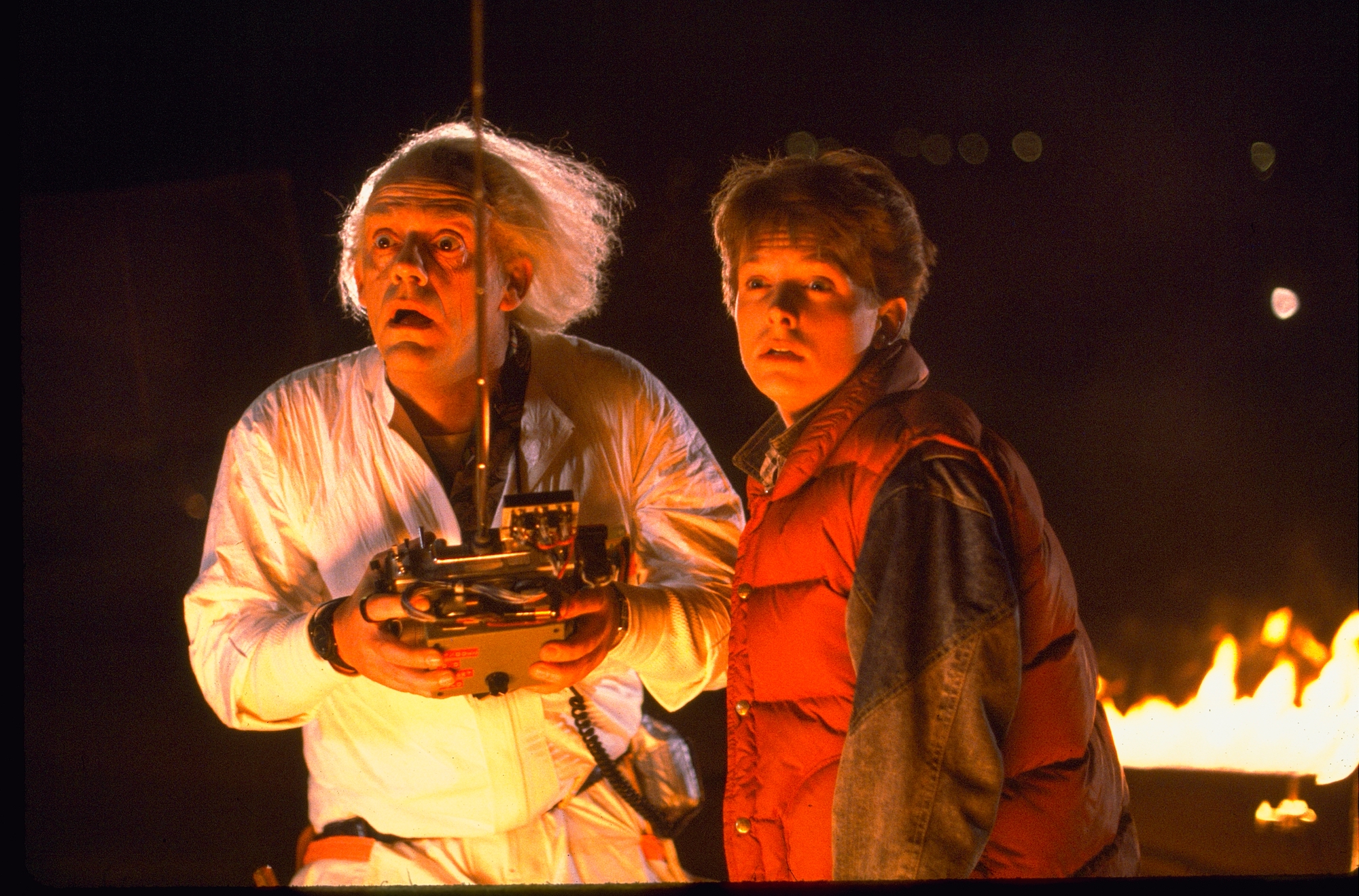'Back to the Future,' and lessons in franchise building
'Back to the Future' offers a template for what to do - and not to do - when a hit film becomes a blockbuster franchise.

A week doesn’t go by without someone trying to revisit - or relitigate - the Star Wars sequel trilogy. Did J.J. Abrams ruin the arc of the series by embarking on the beginning and ending without a game plan? Or did Rian Johnson’s second chapter so disrupt Abrams’ momentum that tying everything together became impossible? Any why on earth wouldn’t Lucasfilm develop what they knew would be a trilogy without deciding upon at least a few ideas from the beginning? The answers, unfortunately, are largely academic. But Star Wars is far from the first overarching story to get underway without a specific conclusion in mind. I mean, have you ever seen Back to the Future?
Newly released on 4K UHD, the Back to the Future trilogy offers a pretty perfect glimpse at what has happened, and continues to happen, nine times out of ten with regard to films that achieve any level of commercial success. That doesn’t make the second and third installments failures - in fact, far from it. But Back to the Future is the quintessential 1980s franchise, offering a guidebook, and object lesson the vagaries of franchise filmmaking, as well as a reminder for fans to not to take those twists, changes or new directions too personally.
Sequels, of course, were nothing new by 1985, much less when Star Wars broke box office records in 1977, but franchises have truly become the bedrock of the entertainment industry. If something does well, it’s not only worth doing two or three times but creating an interconnected synergistic universe comprised of tie-ins and cross promotion. What has changed from follow-ups spinoffs of the past is the idea that each installment is part of “long form storytelling” - that there’s a bigger saga or narrative being considered, and more importantly, mapped out in detail from the very beginning. Part of this evolution is due to the rise of premium television and the minimization of shows with an episodic structure. This change has given rise to a lot of criticisms, with mixed validity, about the failures of storytellers and creators to anticipate what their characters will or should do.
But when Robert Zemeckis and Bob Gale first conceived the premise for Back to the Future in 1980, they had one idea in mind - “would I have been friends with my father in high school?” - and no plans for a multi-tiered adventure that jetted through multiple timelines, looped around on itself, and attempted to reconcile the paradoxes created by their original time travel scenario. 35 years after the release of the original film, it’s almost surprising that they seemed to have no clue that they were capturing lightning in a bottle: not only were they catching the tail end of a Baby Boomer obsession with the 1950s, but combining that with an ‘80s fixation on the boundless possibilities of technology, bound together with a clash of generations (and eras of pop culture) that attracted the same teens and adults that they satirized.
For fellow 10-year-olds in 1985, Back to the Future was a transcendent experience, bolstered by the chart-topping grooves of its then-ubiquitous soundtrack. It was truly a film that the entire family could watch together. Michael J. Fox was catapulted to superstardom. Every idea felt tightly plotted and cleverly executed. Its emotional beats were smart, compelling and evocative. Its resolution - awarding cathartic victories not just to Marty but George (Crispin Glover) and Elaine McFly (Lea Thompson) while Biff Tannen (Thomas F. Wilson) assumes his rightful place as a disgraced bully - was rich and satisfying. If only Zemeckis and Gale hadn’t put Jennifer in the back seat of the DeLorean…
In fact, it’s by Zemeckis and Gale’s own admission that they wished the first film hadn’t ended with the three of them in the DeLorean, and sequels were never considered until after the popularity of the original exploded. Gale initially developed a second film set in 1967 while Zemeckis was busy with Who Framed Roger Rabbit, but Zemeckis rightfully pointed out that the time paradoxes of revisiting the event of the first film, rather than simply seeming repetitive, would give them new creative possibilities. Meanwhile, the prospect of going “into the future” promised a vision unlike anything that this particular 13-going-on-14-year-old had ever seen. All that was needed now was an idea to drive a new time traveling adventure, and a story to satisfy the dangling question mark of “it’s about your kids!”
What happened, unfortunately, is Zemeckis and Gale created a deeply uneven, reverse-engineered narrative that kinda technically satisfied the set-up they teased in Back to the Future while overcomplicating it with out-of-nowhere character beats. Even as a kid, I remember thinking Marty’s obsessive, near-deranged response to being called “chicken” was not part of his character in the first film, but the way they test his reaction to being challenged is the kind of behavior that, well, a movie character displays, not a real person. Marty’s fearlessness in the original film is to be admired, and made the character sympathetic; in Part II, he’s fragile, careless and dopey. And even if Jennifer was not a part of the original plan with regard to Marty and Doc’s misadventures, the way she’s treated as a character is so bad that you wish they simply re-shot the end of the first film and ignored her completely.
The latest updates, reviews and unmissable series to watch and more!
I mean, it’s one thing for them to fly her to the future where she sees that she and Marty are married - there’s obviously something funny and intriguing about that. But not only do Marty and Doc repeatedly incapacitate or knock her out to “protect her from seeing too much of her own future,” but they keep dropping her off, unsupervised, in unsafe areas - first, abandoned in an alley, and later, asleep on her alternate-1985 front porch. The idea that time will straighten itself out, and therefore protect her from harm, feels inadequate given the risks to which they’re subjecting her.
Then there’s also the second film’s keystone-cops snooping by Marty as he follows both 2015 Biff and 1955 Biff, hiding in the back seat of a car with his head exposed - stuff that is just beneath the intelligence and creativity to Zemeckis and Gale (or at least the Zemeckis and Gale of the first film). Their ability to anticipate and play on tons of small details from each film to see how locations and peripheral characters have grown or changed offers a delightful wealth of easter eggs and cute discoveries (from Twin Pines to Lone Pines and so on). Why couldn’t they have gotten right the characters they claimed to love the most?
The answer seems to be, well, they were more focused on the final chapter than the second one, or perhaps took a different approach with more emphasis on an emotional throughline than a chronological one. The third film only reiterates that it is possible to start from scratch with a sequel and succeed as long as your goals are clear. That they wrote both sequels simultaneously makes the second film’s failure slightly more mysterious, but then again, the second film needed to push the story away from the pretty clear and definitive resolution of the first, while the third merely had to bring all of those disparate ideas together. But what makes Part III particularly successful is the idea that what drives Doc and Marty is not the artifice of a dumb manufactured character defect but (1) a need to get back to the present, and (2) the fulfillment of the personality traits that we understand and can relate more directly to. Essentially, where Part II fails is in worrying too much about the mechanics of time travel, and where III succeeds is in exploring the emotional dimension of that experience.
First, there’s the McFly family and the way that Marty is or is not a descendant of the values and ideas of his ancestors. (The notion that every generation’s version of Lorraine marries every McFly is one we won’t dwell too much on here.) Marty travels back in time to save Doc Brown “again” and finds himself tested by a heroic inclination to stand up against bullies, though it’s manifested again in that dumb business of being called “chicken.” Then, there’s the idea that Doc himself is a man of science in an age of brutishness, leading him to retreat into a past where he feels he can do more - and as it turns out, his chivalry, and his eccentricity, might thrive. And then finally, the problem-solving of escaping the time period creates a story that necessitates a similar fixation on science itself - fictional science, of course, but one where these characters must reason through their problems rather than dealing with bolts of lightning and other more conspicuously made-up challenges. That the film literally goes back to a bygone era, and that it uses those anachronisms of the present and past to examine character and cultural norms rather than as easy punchlines, elevates it to something close to great - or closer than Part II, anyway.
Ultimately, it’s that return to the core values of the characters, almost irrespective of the plot, that rescue the franchise from disintegrating - not just as a story, but in the estimation of the millions of fans of the original film. What we have unfortunately seen in less successful but similar circumstances is a focus on technology, on star wattage, or on creating “complications” of story that do not derive from who these characters originally are when audiences fall in love with them, and the worldview they are trying to adhere to, regain or protect.
Because Back to the Future is one of our most enduring franchises in part because Zemeckis and Gale chose not to milk a marketable idea for everything it’s worth, but because even if they lost their way, they brought their three-film adventure home the same way they started - not by chickening out and kowtowing to the monetary and technological possibilities earned by their own success, but by being brave and staying true to their original vision to move audiences through different feelings, and not just time periods.
Todd Gilchrist is a Los Angeles-based film critic and entertainment journalist with more than 20 years’ experience for dozens of print and online outlets, including Variety, The Hollywood Reporter, Entertainment Weekly and Fangoria. An obsessive soundtrack collector, sneaker aficionado and member of the Los Angeles Film Critics Association, Todd currently lives in Silverlake, California with his amazing wife Julie, two cats Beatrix and Biscuit, and several thousand books, vinyl records and Blu-rays.


